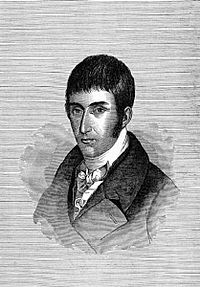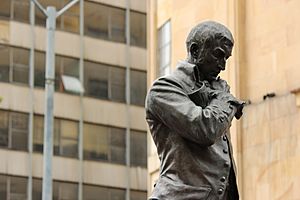Francisco José de Caldas facts for kids
Quick facts for kids
Francisco José de Caldas
|
|
|---|---|

Woodcut of Francisco José de Caldas from the Papel Periodico de Bogotá
|
|
| Born |
Francisco José de Caldas y Tenorio
4 October 1768 Popayán, Viceroyalty of New Granada
|
| Died | 28 October 1816 (aged 48) Bogotá, Cundinamarca, United Provinces of New Granada
|
| Cause of death | Execution by firing squad |
| Resting place | Iglesia de San José Popayán, Cauca, Colombia |
| Nationality | Neogranadine |
| Other names | El Sabio ("the wise") |
| Education | Lawyer |
| Alma mater | Universidad Santo Tomás |
| Occupation | Militar Engineer, Geographer, Botanist, Astronomer, Writer |
| Known for | Precursor of the fight for the independence of Colombia. Geographer, mathematician, astronomer and inventor of first hypsometer. |
| Parent(s) | José de Caldas y Gamba Vicenta Tenorio y Arboleda |
Francisco José de Caldas (born October 4, 1768 – died October 28, 1816) was a very smart Colombian. He was a lawyer, a military engineer, and a naturalist who taught himself about nature. He was also a mathematician, a geographer, and an inventor. He even created the first hypsometer, a tool to measure how high places are.
Caldas was a key person in the fight for New Granada's independence from Spain. New Granada is what we now call Colombia. Because of his important role, he was executed by Pablo Morillo during the time when Spain tried to take back control. Many people consider him the first Colombian scientist. He is often called "El Sabio," which means "The Wise One" in Spanish.
Contents
Biography
Early Life and Education
Francisco José de Caldas was born in Popayán, Colombia, in 1768. His parents were José de Caldas and Vicenta Tenorio. His aunt was the mother of Camilo Torres Tenorio, another important independence leader.
Caldas studied at the Seminary of Popayán. There, he met other future leaders of the Colombian independence movement, like Francisco Antonio Zea. In 1788, his father wanted him to study law. So, Caldas moved to Santafé (now Bogotá) to study at the Colegio del Rosario. He earned his law degree in 1793.
Even though he studied law, Caldas was always more interested in science. He loved mathematics, astronomy, and the natural sciences. After finishing his studies, he went back to Popayán. He tried to manage his family's businesses and work as a trader, but he wasn't very good at it.
Scientific Discoveries and Career
Exploring New Granada
Caldas often traveled to Santafé for business. But during these trips, he spent most of his time observing nature and making scientific notes. He was especially interested in finding the exact location and height of different places. He always carried a barometer, a thermometer, and a compass with him.
One day, his thermometer broke. This accident led him to invent the hypsometer. This device could figure out a place's altitude by measuring the boiling point of water. His detailed notes and observations from this time are still available today. They include a map of the Prado river in Tolima, notes about medicinal plants, and descriptions of ancient stone carvings.
Working with Famous Scientists
Caldas sent his observations about plants growing near the equator to José Celestino Mutis. Mutis was a famous botanist who led the Royal Botanical Expedition of New Granada. Mutis was so impressed that he invited Caldas to join the expedition.
On December 31, 1801, Caldas met two very famous scientists: Alexander von Humboldt and Aimé Bonpland. He met them in Ibarra after a trip to Quito. Humboldt was amazed by Caldas's scientific achievements, especially since Caldas lived in a less developed area like Popayán. Caldas shared his altitude data with them and became their friend. They even explored areas around Quito together.
Leading the Astronomical Observatory
In 1805, Caldas returned to Santafé and started working for the Botanical Expedition. Mutis put him in charge of the new Astronomic Observatory. In 1808, Caldas also started a newspaper called "El Semanario" (The Weekly). He published many of his scientific articles in it.
When Mutis died in 1808, Caldas hoped to become the new director of the Botanical Expedition. However, Mutis had chosen his nephew, Sinforoso Mutis. Still, Caldas remained the director of the Astronomical Observatory. He was also tasked with studying the plants of Bogotá and teaching basic mathematics at the Colegio del Rosario.
Political and Military Life
The Start of Independence
After Mutis passed away in 1809, future independence leaders began meeting secretly at the Observatory. These included Caldas's cousin, Camilo Torres Tenorio, and Antonio Nariño. Caldas allowed these meetings, but he was mostly focused on his scientific work. During this time, he continued to publish his "Scientific Memoirs."
Caldas played an active role in the events of July 20, 1810. This day is considered Colombia's official Independence Day. A plan was made to start a local government, called a "junta," in Santafé. The idea was to ask a Spanish merchant, José González Llorente, to lend a flower vase for a celebration. They hoped he would refuse, which would anger the local people (Creoles) and lead them to demand a junta.
Caldas agreed to be there when the request was made. As planned, Llorente refused, and Caldas pretended to be upset. This sparked shouts of anger against the Spanish. Soon, a revolt began, and the Spanish Viceroy agreed to form the Santafé junta. This event marked the beginning of Colombia's independence.
After Independence
After July 20, 1810, Caldas and Joaquín Camacho were asked to create the first newspaper of the new Republic. It was called the "Diario Político de Santafé de Bogotá." It started on August 27, 1810. The newspaper described all the events of the junta's creation and published articles about politics and economics. Caldas also continued to publish his Scientific Memoirs.
In September 1811, Antonio Nariño became President of the Free and Independent State of Cundinamarca. He formed the Army Engineer Corps, and Caldas was made a Captain. His job was to map roads and travel routes. Caldas later joined General Antonio Baraya's troops, who were fighting against the federalists. However, Baraya switched sides to support the federalists, and Caldas joined him. Caldas became a Lieutenant Colonel in the Military Commission of the Congress. He took part in battles, including the Battle of Ventaquemada in December 1812, where the federalists won. But they were defeated in the Battle of San Victorino in January 1813.
After this defeat, Caldas escaped to Popayán. But when he found that royal Spanish troops had taken over, he went to Antioquia. Antioquia had declared itself an independent state. The leader of Antioquia, Juan del Corral, welcomed Caldas. He appointed Caldas to create a Military School and made him Director of Rifle Factories and General Engineer, with the rank of Colonel. Caldas was in charge of building factories for gunpowder and guns. He also taught at the Academy of Engineers in Medellín in 1814. He worked on fortifying the Cauca River and setting up weapons factories.
By late 1814, the Spanish had defeated and arrested Nariño. Simón Bolívar and his army had forced Cundinamarca to join the United Provinces. The government, worried about Spain trying to reconquer New Granada, called Caldas back. They wanted him to build another Military School and to construct bridges, trenches, and defenses around the city. He was also sent to fortify roads in Quindío.
Death
Pablo Morillo and his Spanish forces finally captured Santafé on May 6, 1816. Like other independence leaders, Caldas tried to escape the city. He hoped to reach Buenaventura and leave the country. However, on his way, the Spanish royalist troops, led by Sámano, won a battle and recaptured Popayán.
Caldas was forced to hide on a farm in Sotará. But he was soon arrested by the Spanish in 1816. He was sent back to Santafé and executed by a firing squad on October 29, 1816. This happened in the San Francisco Plaza (now Santander Park) by order of Pablo Morillo. When people begged Morillo to spare the scientist's life, Morillo famously replied: "Spain does not need savants" (meaning "Spain does not need wise men"). Before he died, Caldas wrote a large Greek letter θ on a wall. This letter was used in ancient Athens to mean "death." People believe he was saying, "Oh, long and dark departure!"
His body was first buried in the Church of Veracruz. Later, it was moved to the Panteón de los Próceres (Pantheon of Heroes) in his hometown of Popayán.
Legacy
Francisco José de Caldas left a lasting impact on Colombia.
- He helped establish the New Kingdom of Granada Seminary, a scientific institution in the early 1800s.
- In 1810, he founded the Diario Político de Santa Fe (Political Diary of Santa Fe). This newspaper strongly supported the independence movement.
- Because of his work in the Army Engineer Corps, some people call him the "father of Colombian engineering."
- The Colombian department of Caldas is named after him.
- The Francisco José de Caldas District University, a large public university in Bogotá, also carries his name.
- The "Francisco José de Caldas" Scholarship helps Colombians study for their PhDs.
- Caldas's face was once featured on the $20 Colombian peso banknotes.
Books
- "El estado de la geografía del virreinato con relación a la economía y al comercio" (1807) - This book was about the geography of the viceroyalty and how it related to the economy and trade.
- "El influjo del clima sobre los seres organizados" (1808) - This work discussed how climate affects living things.
- "La Memoria sobre la Nivelación de las Plantas del Ecuador, Historia de Nuestra Revolución, Educación de Menores, Importancia del Cultivo de la Cochinilla y Chinchografía y Geografía de los Arboles de Quina" - This is a collection of his writings on various topics, including plants of Ecuador, the history of the revolution, and the geography of quinine trees.
See also
In Spanish: Francisco José de Caldas para niños


